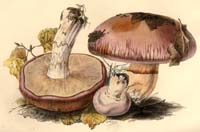 Key to Gilled Mushrooms Key
Key to Gilled Mushrooms KeyThis is a key to gilled mushrooms, that is, mushrooms having a definite cap with a fertile surface consisting of gills. The fruiting body usually also has a stem, although that may be lateral or absent (usually, then, the mushroom is growing from wood). You can use this key to identify mushrooms that you find.
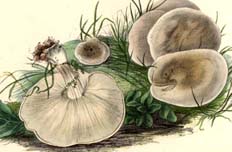 Agaricales Order
Agaricales OrderFruiting body containing fibers (usually in the stalk)
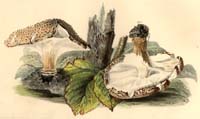 White Spored Suborder
White Spored SuborderSpore print "light-colored": white or buff, sometimes tinged with pink or tan. Greenish and (except for the Russulales) yellow spore prints also go here
Stalk fibrous, not fracturing like a piece of chalk
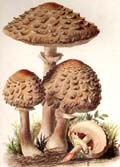 Lepiota Genus
Lepiota GenusGills free
Annulus usually present (on some small species, the partial veil may remain instead as scraps of tissue on the edge of the cap)
Cap often umbonate, often with a concentric design of scales that are an intrinsic part of the cap (not easily peeled off without taking part of the cap with it)
The cap is also usually egg-shaped or completely round (like a globe) at first - - it doesn't start to open until the stem is almost fully grown
 Little Lepiotas Section
Little Lepiotas SectionCap less than 3" across at maturity; usually less than 2
If flesh changes color when cut or bruised, it turns red, without any preliminary color
Cap scaly or powdery (or both!)
Stem typically tough, fibrous
Ring typically persistent, membranous
Powdery Little Lepiota SubSection
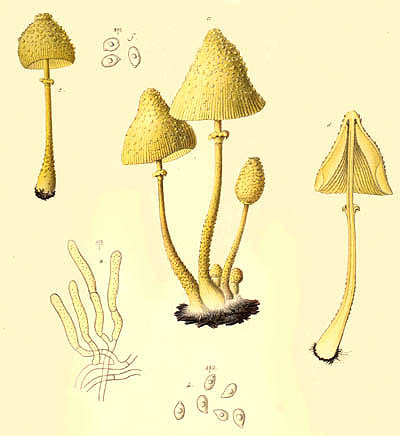
Diagnosis
Narrow down your identification:
Lepiota cepaestipesEntire fruiting body white, covered with white flakes
Cap umbonate at maturity, margin striate
Stalk with an enlarged base; sometimes swollen in places
Outdoors across the country in dense clusters in wood chips, mulch, and leaf piles
Lepiota clypeolariaCap flat in center (not umbonate); not powdery or shaggy except at the margin, which is hung with shaggy veil fragments
Cap cuticle brownish orange, breaking up into scales as the cap expands; the flesh that shows between the scales is white; the disk stays solid brownish orange, darker than the rest of the cap; often yellower towards the margin
Stalk covered with shaggy veil remnants below where a ring would be; annulus cottony, often evanescent or indistinguishable from the other veil remnants on the stem
On the ground in woods
 Lepiota lutea
Lepiota luteaEntire fruiting body yellow
Cap umbonate in maturity
Stalk often enlarged at the base
Only grows outdoors in warmer, more humid climates, but one of the most common mushrooms to turn up in greenhouses, window boxes, and other protected settings
Lepiota luteophyllaCap smooth, not powdery or breaking up into scales, becoming wrinkled in age; some shade of brown, margin fading to light brown or creamy white in age; not striate
Gills bright yellow
Stalk some shade of yellow above, brown below
Partial veil fibrillose; sometimes evanescent, sometimes leaving a fibrillose ring plastered to the stem
Leucocoprinus fragilissimusCap up to 1 3/4" across; translucent-striate, sometimes also sulcatebright yellow over most of the cap, paler and more transparent at the margin, browner and more opaque at the disk; extremely thin and fragile
Stalk pale greyish yellow at first, darkening in age; coated with tiny yellow scales; extremely thin and fragile
Growing solitary or sparsely on the ground in woods
Leucocoprinus lilacinogranulusCap cuticle purplish brown, breaking up into scales as the cap expands; the flesh that shows between the scales is white; the disk is flat (not umbonate) and stays solid purplish brown
Gills sometimes pinkish and crinkled in age
Stalk often fusiform below the ring
Only grows outdoors in warmer, more humid climates, but it turns up in greenhouses, window boxes, and other protected settings

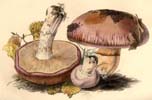


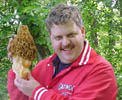

 Key to Gilled Mushrooms Key
Key to Gilled Mushrooms Key Agaricales Order
Agaricales Order White Spored Suborder
White Spored Suborder Lepiota Genus
Lepiota Genus Little Lepiotas Section
Little Lepiotas Section
 Lepiota lutea
Lepiota lutea




